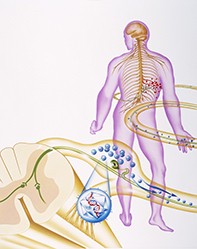Peer Reviewed
Feature Article Infectious diseases
Postherpetic neuralgia: how to prevent it, how to treat it
Abstract
Postherpetic neuralgia (PHN) is a common late complication of acute shingles. This neuropathic pain is often severe and accompanied by sensitivity to touch. It significantly impairs the quality of life of affected patients. The difficulties in treating PHN justify preventive measures such as vaccination and early aggressive management of the acute shingles episode.
Key Points
- Shingles, resulting from reactivation of varicella-zoster virus (VZV; the cause of chickenpox) is a common acute disease, particularly in elderly and immunocompromised patients.
- The shingles rash is accompanied with, or may be preceded by, acute, often severe pain; the persistence of neuropathic pain beyond three months is described as postherpetic neuralgia (PHN).
- PHN occurs more often in the elderly and has significant negative effects on quality of life.
- Vaccination with attenuated VZV is a preventive strategy reducing incidence of acute shingles and thereby PHN; it is recommended for patients over 60 years and will be funded for patients over 70 years from November 2016.
- Treatment of PHN should follow established guidelines for neuropathic pain; in view of the localised pain and the typically elderly and frail patients affected, topical lignocaine 5% patch is a specific first-line treatment option.
- Systemic first-line treatments include pregabalin, gabapentin, tricyclic antidepressants and serotonin-noradrenaline reuptake inhibitors, with tramadol second-line and conventional opioids third-line options.
Picture credit: © John Bavosi/SPL.
Purchase the PDF version of this article
Already a subscriber? Login here.

